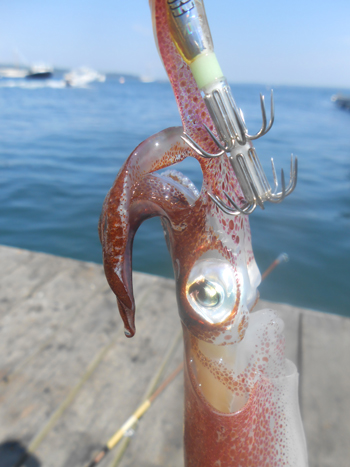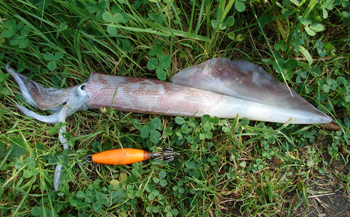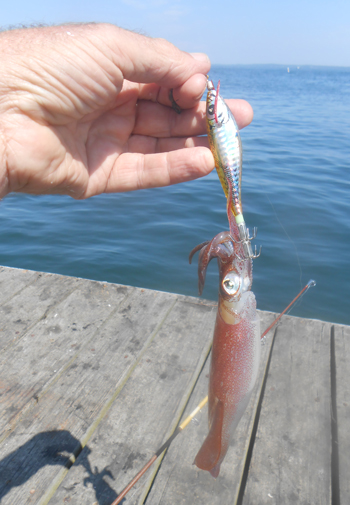Maine Anglers Score With Squid
by Tom Seymour

Squid have exceptional vision, as attested by their huge eyes. Tom Seymour photo
While mackerel fishing, something different tugs on the line. It doesn’t strike hard like a mackerel but rather, just slowly pulsates. Reeling in, the angler gets a big surprise. A squid has taken the mackerel jig.
What comes as even more of a surprise for the first-time squid catcher, when pulled from the water the thing squirts bursts of black, inky liquid. That is the squid’s defense mechanism. Like the closely-related octopus, squid expel this “ink” as a cloaking measure. Any pursuer is confused and can no longer see the squid, which is just what the squid wants, since this black cloud allows the invertebrate to escape unseen.
So the first lesson for squid fishing is to hold the critter over the water and allow it to squirt out all its ink before bringing it in. Many the incautious angler, the author included, has gotten a face full of ink as a reward for carelessness.
True chameleons of the sea, squid have the ability to change color to match their surroundings. They also switch shades when alarmed or aggravated. This takes only seconds and people catching squid often note their near-instant color changes.
Squid are invertebrate mollusks, the same as octopi. They have a long, flat cartilaginous “skeleton” inside their tube (body) and this gives the animal support. This skeleton, called a “pen,” looks much like a quill from a duck and could easily serve as an ersatz ink pen.
Two kinds of squid enter Maine waters in spring and work their way up the coast in summer. These are longfin squid, Loligo pealei, and shortfin squid, Illex illecebrosus. Squid swim in large schools and while the largest schools remain out in open water such as bays, smaller schools enter harbors where they are taken by anglers fishing from small boats and also piers and floats.

Squid on the grass with an old-fashioned heavy squid jig below it. Tom Seymour photo
Squid have exceptional vision, as attested by their huge eyes. But even their great eyesight is of little value when a school of bluefish slash through a school of squid. Sea birds, too, double-crested cormorants in particular, feast on squid.
Longfin squid are fished commercially and are sold as calamari. These squid can grow up to 24 inches in length, while the shortfin variety run 8- to 10-inches long.
Squid eat by first wrapping their tentacles around a prey and then drawing it in to where they can devour it with their sharp beaks. These beaks can inflict substantial damage on human hands, so when handling any squid, make certain to keep hands and fingers away from the squid’s mouth.
While squid visit Maine each year, some years see greater numbers of squid than others. This often coincides with water temperature. Extended hot spells and resulting warming water temperatures can make for a squid-filled summer along the Maine coast.
Squid Fishing
Old-timers used colorful, cigar-shaped squid jigs. These had several sets of upturned, barbless spikes on the bottom and when a squid wrapped its tentacles around these it could not let go. These jigs were heavy and sunk quickly. They still have their place and that is when squid fishing from a boat. When trolling or drifting, just leave a line or two out with a heavy squid jig on the end. In the past, most people used handlines for this and that’s still a viable option. Either way, a few squid lines allowed to hang down 10 or so feet below the surface allow the angler to continue fishing for whatever finfish might be in the area.
Modern squid jigs, however are examples of technology at its finest. These are shaped like a small fish and have translucent bodies with reflective holographic images on the outside. These even have ersatz pectoral fins, represented by a clump of feathers on either side. When the jig is twitched, the “fins” pulsate, giving a lifelike appearance.
If squid are near bottom, it pays to attach a dropper line with several lead weights to the jig. Most of the time, though, the best method is to cast out and allow the partially-buoyant jig to slowly sink. While the jig sinks vertically, the angler works the rod in short stages to pull it forward horizontally. The minute something feels different, it pays to begin reeling steadily.
As with finfish, all a squid needs to gain its freedom is slack line. A brief moment of inattention and the squid is gone. Also, when finally getting the squid close-at-hand, lift it from the water gently, as in slow motion. Often, a squid will have only one tentacle stuck to the jig and these break easily.
Some of the best squid fishing occurs on an incoming tide, three-quarters of the way in. High tide can also be good, since schools of squid tend to hang around piers and floats at this time. Besides that, traveling schools of squid can appear almost anywhere.
Finally, squid, perhaps even more than finfish, require the best of care. This means keeping them cold. An ice-filled cooler serves the purpose for most people. If squid are allowed to turn warm, they quickly spoil.

Squid lightly hooked on modern Youzuri plug. Tom Seymour photo
Traditional Avocation
While people from southern New England and all the way up to Newfoundland have a proud history of squid jigging, it was the Newfoundlanders who have a song devoted to squid jigging. “Squid-Jiggin’ Ground” was written by Arthur Scammell in 1928. The song goes to the traditional tune, Nell Flaherty’s Drake.
While Newfoundlanders have jigged for squid since time immemorial, this may be the first time anyone has penned a song about the practice. Here are the last two parts of Scammell’s somewhat lengthy song:
Says Bobby, “The squid are on top of the water
I just got me jigger ‘bout one fathom down”
When a squid in the boat squirted right down his throat
And he’s swearin’ like mad on the squid-jiggin’ ground.
Now, if ever you feel inclined to go squiddin’
Leave your white shirt and collars behind in the town
And if you get cranky without your silk hanky
You’d better steer clear of the squid-jiggin’ ground.
And back in Maine during the heyday of the sardine industry, line workers often came home with several meals worth of squid that had come along the line along with herring. The author was first introduced to squid by a friend who worked at cutting herring in a sardine factory.
Squid Recipes
Squid lend themselves to a number of preparation methods. While deep-fried calamari is probably the best-known recipe, some people substitute squid for meatballs when making an Italian pasta sauce.
Everyone has their favorite cooking method and the author’s favorite is sautéed squid with crushed garlic and olive oil. Just think shrimp scampi, but substitute squid for shrimp. Also, both the tubes and the tentacles are equally good. When cleaning the squid, the tube is cut in “rounds” and the tentacles are removed intact from the head.
Finally, squid keep well in the freezer and stay fresh for up to one year. Inexpensive, productive and loads of fun, squid jigging is everyone’s game.
